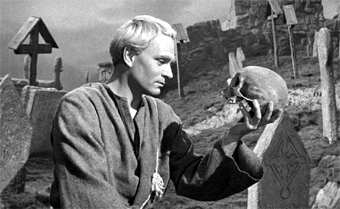
Laurence Olivier as Hamlet (1948);
image courtesy of Two Cities Films/
Universal Pictures
To Have a Head, Or
Not to Have a Head
| published March 25, 2016 |
By Keith H. Roberts, Thursday Review contributor
William Shakespeare was a true man of mystery, not in the Austin Powers sense of the word (though one could indeed make that case too), but in the sense that the Bard has left behind a complex and diverse legacy of little mysteries and cyphers.
Among the most infamous rumors: The man called “Shakespeare” was just a literary patsy—a stand-in, if you will, for the real writer of such immeasurably important works as Othello, King Lear, Romeo and Juliet, and MacBeth. According to this farfetched but seemingly immortal crank theory, the real writer of the most famous works in the English language was a well-placed member of British upper crust society, possibly even a member of the royal family. The man known as Shakespeare was merely his hired shill, a fair-to-middling regular guy who received a small percentage of the profits for acting as stand-in for a literary genius member of the royal court.
Hogwash, most scholars agree. Still, the theory sprouted legs centuries ago and persists event to this day, ranking up there just below the Faked Moon Landings (one of the most ridiculous) but squarely above most Elvis sightings.

Shakespeare was laid to rest a half millennia ago in England, only a short walk from where he wrote and directed and performed. But now, even his final resting place—universally believed to be in a stone burial crypt inside the Church of the Holy Trinity in Stratford-on-Avon next to that of his wife, Anne Hathaway—lends confusion to his legacy.
Rumors have persisted for more than 150 years that grave robbers may have—in earlier times—dug up the Bard’s final remains and tampered with what they found, possibly stealing Shakespeare’s skull for either its collector’s value, or for its value to those who made great fortunes studying skulls at a time when some folks put a lot of stock in studying the cranial capacities and mapping the skull structure of the world’s smartest people. Then, there were those who simply enjoyed collecting the skulls of the famous and the infamous, much in the same way that people collect art, or cars, or guitars in the 21st Century.
Now it turns out that those rumors, which began in earnest in 1879 after the British magazine Argosy published an investigative report about grave-robbing, may be true. Researchers have discovered anomalies in the area where Shakespeare is buried, a “disturbance” in the scans of the burial site which indicate not only that the contents were removed and then hurriedly placed back inside the grave, but also that Shakespeare’s body has no head—the skull apparently removed by the individuals who disrupted the grave centuries ago.
A research team led by Kevin Colls of Staffordshire University recently told The Guardian that he and his colleagues—using ground-penetrating radar and state-of-the-art imaging systems—discovered that the area believed to contain Shakespeare’s remains was at one time emptied and then repacked. The radar at first indicated a disturbance in the patterns of soil and rock and other material, but Colls and his fellow researchers soon realized they were looking at an area which had been excavated—dug up, then quickly refilled.
What impact this new discovery will have on the world of literature is unclear. But it adds to the always interesting backstory that was Shakespeare’s life. It also lends a bit of dark irony to a famous scene from Hamlet, in which the lead character muses aloud on the meaning and manner of both life and death while holding aloft a skull.
A television network in Britain will air a full-length documentary on the findings this weekend, and the documentary will air worldwide within a few months.
“These results will undoubtedly spark discussion, scholarly debate, and controversies for years to come,” Colls said, “Even now, thinking of the findings send shivers down my spine.”
Related Thursday Review articles:
Shadow Divers and Pirate Hunters; Roberts Kurson; book reviews by Lisa Whitten; Thursday Review; September 1, 2015.
J.R.R. Tolkien: A Life Inspired; Wyatt North; book review by Lisa Whitten; Thursday Review; January 8, 2015.
